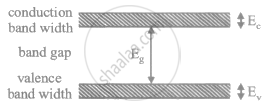Advertisements
Advertisements
Question
The conduction band of a solid is partially filled at 0 K. Will it be a conductor, a semiconductor or an insulator?
Solution
It will be a conductor. As the elements having partially filled conduction band belong to the category of elements whose outermost subshell consists of an odd number of electrons, they are good conductors of electricity. When an electric field is applied, electrons in the partially filled band gain energy and start drifting. So, the conductor will conduct even at 0 K. A semiconductor behaves like an insulator at 0 K and an insulator conducts poorly only at very high temperatures.
As the given material has free electrons to conduct even at 0 K, it is a conductor.
APPEARS IN
RELATED QUESTIONS
Distinguish between a conductor and a semi conductor on the basis of energy band diagram
Write two characteristic features to distinguish between n-type and p-type semiconductors ?
Distinguish between a conductor, a semiconductor and an insulator on the basis of energy band diagrams.
There are energy bands in a solid. Do we have really continuous energy variation in a band ro do we have very closely spaced but still discrete energy levels?
In semiconductors, thermal collisions are responsible for taking a valence electron to the conduction band. Why does the number of conduction electrons not go on increasing with time as thermal collisions continuously take place?
What is the resistance of an intrinsic semiconductor at 0 K?
A p-type semiconductor is
When an impurity is doped into an intrinsic semiconductor, the conductivity of the semiconductor
In a transistor,
In a semiconductor,
(a) there are no free electrons at 0 K
(b) there are no free electrons at any temperature
(c) the number of free electrons increases with temperature
(d) the number of free electrons is less than that in a conductor.
Indium antimonide has a band gap of 0.23 eV between the valence and the conduction band. Find the temperature at which kT equals the band gap.
Let ΔE denote the energy gap between the valence band and the conduction band. The population of conduction electrons (and of the holes) is roughly proportional to e−ΔE/2kT. Find the ratio of the concentration of conduction electrons in diamond to the in silicon at room temperature 300 K. ΔE for silicon is 1.1 eV and for diamond is 6.1 eV. How many conduction electrons are likely to be in one cubic metre of diamond?
The conductivity of an intrinsic semiconductor depends on temperature as σ = σ0e−ΔE/2kT, where σ0 is a constant. Find the temperature at which the conductivity of an intrinsic germanium semiconductor will be double of its value at T = 300 K. Assume that the gap for germanium is 0.650 eV and remains constant as the temperature is increased.
(Use Planck constant h = 4.14 × 10-15 eV-s, Boltzmann constant k = 8·62 × 10-5 eV/K.)
If the lattice constant of this semiconductor is decreased, then which of the following is correct?

For germanium crystal, the forbidden gas energy gap
A semiconductor is cooled from T.K to T2K its resistance will
In a semiconductor, the forbidden energy gap between the valence, band and the conduction band is of the order of
Which one of the following elements will require the highest energy to take out an electron from them?
Pb, Ge, C and Si
With reference to semiconductor physics, answer the following question.
In which material “Forbidden band” is absent?
